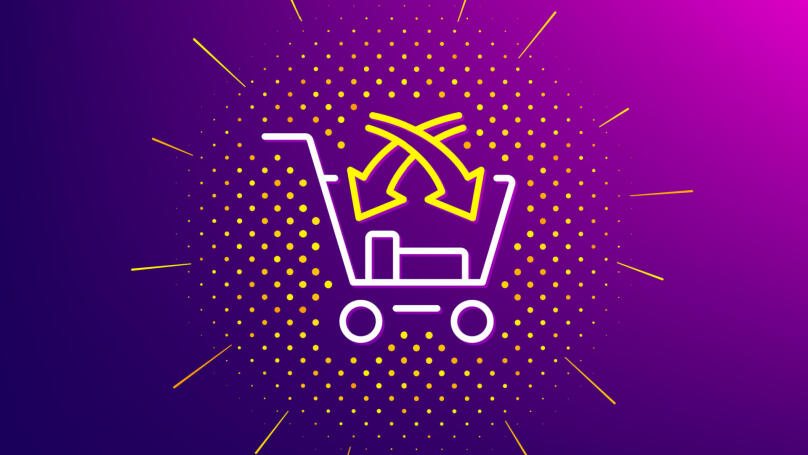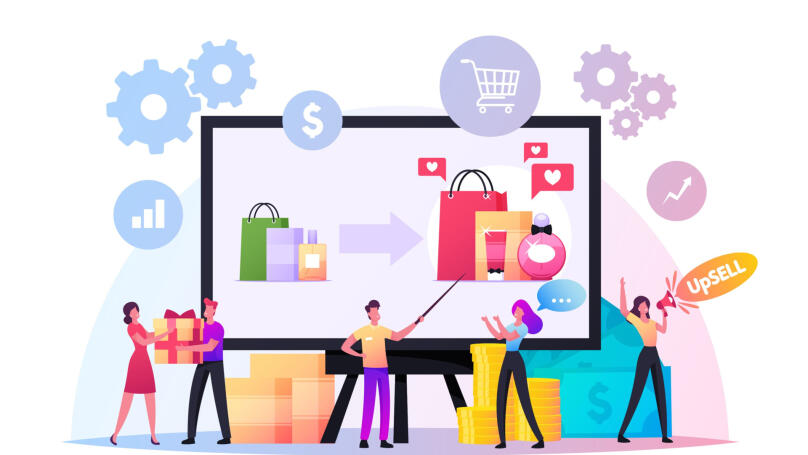Cross-selling

What is cross-selling?
Cross-selling is one of many methods or marketing strategies to increase the average customer spend. It involves providing goods or services that match the consumer's initial purchase. In other words, cross-selling encourages customers to spend more money by selling related products.
This technique is effective in both offline and online sales. For example, when a customer buys a new smartphone, a salesperson also recommends purchasing additional headphones, a screen protector, a case, or another accessory. Likewise, special algorithms in online stores will recommend that users purchase complementary items when using the main product. Retargeting and email newsletters can also be used to promote related products. This helps to increase the company's profits. Still, ensuring that the customer's needs are met is crucial, only to recommend some products.
Why is cross-selling important?
As mentioned before, by utilizing cross-selling techniques, the average customer will spend more. Subsequently, the company's total revenue will significantly increase. According to a study by the international consulting firm McKinsey, targeted online marketing programs increase customer conversion rates, and cross-selling enables you to increase sales by 20% and overall profits by another 30%. Furthermore, the cross-selling technique promotes more active sales of less popular products in low demand.
Simultaneously, cross-selling facilitates a company to improve its relationships with customers and their user experience. This is achievable because when using cross-selling, shoppers will satisfy their most pressing and secondary needs they probably have yet to realize. This enhances the company's customer relationships, contributes to retention, and creates trusting long-term relationships.
The benefits of cross-selling
Companies can effectively improve efficiency and achieve key success statistics through cross-selling techniques. Some of the benefits of cross-selling include:
-
An increase in the average customer spending and the company's total profit.
-
Retaining potential customers, improving the user experience, and satisfying all their needs.
-
Increased customer loyalty and satisfaction.
-
Promotes the sale of goods that are in low demand.
However, for the cross-selling technique to generate tangible results quickly and to ensure the successful implementation of the strategy, it's essential to use it correctly and avoid common mistakes.
Cross-selling techniques

There are several key types of cross-selling:
-
Additional products
This is the most common type of cross-selling when the customer is offered related items from another category or similar items belonging to the same group. In this scenario, the seller determines the buyer's needs, preferences, and interests and suggests purchasing additional products accordingly.
-
Package sales
This refers to a unique combination of the main product and related goods or services, pre-planned and arranged as a profitable package offer.
-
Promotions
Cross-selling promotions can be as follows: the customer must purchase goods for a certain amount of money, and in this case, they can, for example, take advantage of free shipping or receive a substantial discount. In some market segments, for instance, in the retail trade of food products, it is acceptable for a related product to be sold as part of a set, even if it does not complement the main product. So, you can offer a discount on food products in lower demand than essential products.
Depending on the type of cross-selling, this approach can include several popular selling methods:
-
Direct offer of additional products. The sales assistant suggests products that complement the main item in an offline store. In an online store, developers can embed special algorithms that display additional products related to the user's selection.
-
Recommendations based on previously made purchases. This method is highly effective, first of all, in online stores. For instance, after purchasing a product, customers may receive an email newsletter with personalized recommendations for complementary products to enhance their experience, improve their workflow, or accelerate specific procedures.
-
Argumentation. For a potential client to become interested in the offered product, you must demonstrate why they need an additional product. To achieve this, you can use scientific or social arguments, positive experiences based on examples from other customers, and, in the case of online sales, a special block, "Buy with this product."
-
Offering assistance. The seller should mention that the customer may incur additional costs or unexpected losses by refusing other services from the company. Highlight potential difficulties and demonstrate the importance of the company's exceptional technical support.
-
Incentives to buy. A discount, promotion, or bonus can be an additional incentive for consumers to purchase products they were not initially interested in, especially when buying multiple products or ordering over a certain amount.
-
Merchandising or effective product display. Place complementary products next to the main product to attract potential customers. You can also place more colorful and inexpensive products in the checkout area, encouraging shoppers to consider buying and, in most cases, tempting them with a spontaneous, impulse buy.
Cross-selling examples
The most striking example of the cross-selling technique is in a supermarket, where all food products are arranged in a strictly defined order. For example, there are various spices and sauces following meat products. Therefore, a consumer purchasing a meat product will notice related products and, most likely, buy ketchup or pepper to complement the meat. Using the same principle, electronics stores will offer a gaming mouse, cables, chargers, and protective cases next to laptops or computers.
The sales assistant may also recommend that the customer purchase a software license when buying a PC.
However, cross-selling is not only found in retail but also provided services. For example, when booking and checking into a hotel, the receptionist offers the holiday maker spa treatments, a visit to the pool, food delivery to the room, airport transfer, etc. All this ensures a comfortable stay for guests at the hotel and increases their average spend. Travel agencies, for example, follow the same tactics (tactic). When purchasing a last-minute tour, the travel agent can provide customers with additional excursions, luggage insurance, and an airport transfer. In the banking industry, cross-selling is used when customers are asked whether they want a debit card when opening an account or depositing money.
In e-commerce and online sales, cross-selling is represented by the "Buy with this product" or "You may like" tabs on official store websites. For example, when purchasing handicraft products from the Handmade section on Amazon marketplace, users may also be offered creative sets of embroidery, beading, appliqué, painting by numbers, etc. And if you recently purchased a tracksuit or some equipment on eBay, wait for advertisements showing comfortable running shoes.
Common mistakes when using cross-selling

To ensure a successful cross-selling strategy, it is vital to clarify that it should meet four main principles:
- Relevance. The additional items the seller offers must meet the buyer's demands and requirements.
- Specifics. You should bring up to two or three additional products to the customers' attention. Otherwise, you risk creating a kind of "information noise."
- Relevance and significance. Additional products should be suggested when the customer has decided to buy the main product.
- Cost. Additional items should be less expensive than the main ones. It is preferable if the cost of related products is 15-20% lower than the main one.
The cross-selling strategy is unlikely to succeed if at least one of these principles is not met. The most common mistakes when using this strategy are:
-
Staff incompetence. If the salesperson does not have sufficient knowledge about the products on offer and cannot evaluate customers' needs, their recommendations will be useless. Likewise, a competent salesperson must possess relevant skills such as negotiation and the ability to persuade and show empathy.
-
Excessive pressure and intrusiveness. If a product is offered too keenly (this mistake occurs not only offline but also in online sales), then, most likely, the customer will not want to buy it. Generally, hassling someone excessively with a product is worrying and unacceptable.
-
Too much choice. Do not overwhelm the consumer with various products. You should limit yourself to suggesting just two or three additional products.
-
A lack of appropriateness. Providing other goods or services is most appropriate when the buyer has chosen the main product and is ready to purchase it. However, suppose you realize the customer is not interested in a constructive or active conversation about other products. In that case, you should stop trying to sell.
-
Incorrect pricing policy. This issue could arise particularly if the additional product offered by the seller exceeds the cost of the main one.
Therefore, it is essential to use cross-selling only in cases where it is appropriate and suitable.
How to improve cross-selling
For cross-selling to become an effective tool for increasing profits, it is essential to assess its effectiveness regularly. You can increase this cross-selling technique through the following stages:
Stage 1. Studying the target audience
Update your statistics about the target audience for your company's products. Potential customers should be segmented according to social and financial status, interests, and other socio-demographic criteria. This is essential to understand which offers, products, and services will be entirely suitable and wanted by your customers.
Stage 2. Analyzing customer behavior and needs
It is vital to research the factors influencing customers' behaviour and their decisions about whether to buy a particular product or not or whether they might choose another. In the event of online sales, it is essential to determine how site visitors enter various departments. This will let you know which products are most in demand and what you can choose to complement less popular products. You could use, for example, the web analytics service Google Analytics.
Stage 3. Creating a cross-selling matrix
This is the name of a specific document in the form of a table. It encompasses the entire range of products that the company provides. This table must highlight suitable products that can be utilized as related products and the reasons for their connection. In addition to complementary products, there are priority, thematic, seasonal, and impulsive items. This should all be reflected in the cross-selling matrix.
Step 4: Provide customers with valuable products and encourage them to make positive buying choices
At this stage, you should use the cross-selling techniques provided above. Persuade the consumer that a related product will improve their user experience, extend the life of the main product, and eliminate possible challenges and risks. To achieve this, use various communication channels such as email newsletters and targeted advertising, not just personal contact for offline sales. Simultaneously, please refrain from attempting to deceive the customer and sell them a pointless product. Always consider whether the products you offer will be helpful to the buyer. This is precisely what the first two stages of increasing cross-selling effectiveness are for.
Step 5: Monitor cross-selling performance and customer loyalty results
The more loyal customers a company has, the more likely they are to purchase products actively and recommend them to other consumers. This is how you can increase your overall profit and save on brand promotion because loyal customers will talk about your products free of charge.
Cross-selling vs. Upsell and Downsell

In addition to cross-selling, there are other ways to increase the average customer spend, for instance, upsell and downsell.
The definition of upsell involves selling a more expensive item to a customer instead of the one they originally wanted and planned to buy. For example, suppose a consumer has an eye on a MacBook Air M1. The sales assistant could offer them an updated M2 model with more RAM and new features. Suppose they want to purchase more expensive items. In that case, you could offer the customer the option to buy them in larger quantities and receive a discount. At the same time, the product you suggest must be relatively inexpensive compared to the one the consumer initially wanted. Otherwise, they may disagree and decide not to buy anything.
The downsell technique is the opposite of tactical sales, which involves selling a cheaper product to the shopper. This approach is employed when customers cannot buy the product they want. Therefore, the seller's task is not to let the customer leave until they buy a budget-friendly alternative to the product they initially wanted. In other words, the primary goal of downselling is to satisfy a potential buyer's needs in different ways and retain them. However, the downsell technique can only be employed when a product can be easily replaced by another while fully satisfying the customer's requirements. For example, this is feasible in the clothing or fashion industry. So, suppose a buyer wants to buy boots made of genuine leather but cannot afford them. In that case, the sales assistant offers them an inexpensive alternative pair of boots made from artificial leather. Downsell equipment can also often be found in electronics stores. Suppose a potential buyer has his eye on a new iPhone model, but his budget is limited. In that case, you can offer the customer an earlier model or a smartphone from another manufacturer. However, remember that a cheaper product must be comparable to an expensive one; that is, it must completely satisfy the buyer's needs.
Depending on the particular situation, area, and type of business, each technique can be effective in the modern market. These strategies encourage customers to buy a product immediately and boost the company's revenue.
Conclusion
Cross-selling presents an excellent opportunity to improve customer experience, attract new potential customers and increase profits. However, it is essential to use cross-selling techniques wisely to avoid achieving the opposite effect. If a company cares, its top priorities are its customers and their needs, the quality of its products, and retaining a good reputation. Cross-selling will become essential to the successful sales strategy for any business in any activity area.























